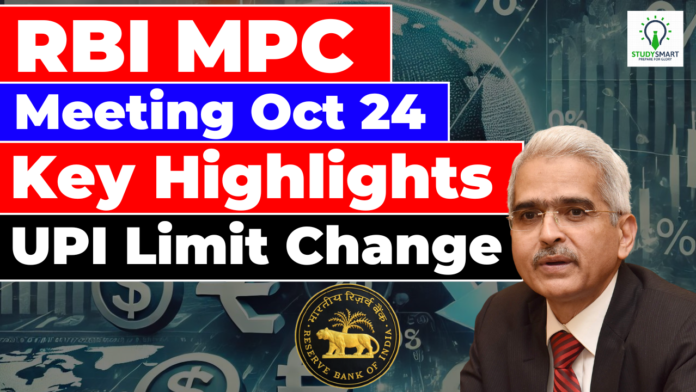RBI Monetary Policy Committee (MPC) concluded its bi-monthly meeting on October 9, 2024. This meeting, the fourth of the financial year 2024-25. Eight years have passed since the implementation of the flexible monetary policy framework. Here are the key highlights and implications of the meeting:
Repo Rate Unchanged
- The MPC decided to keep the repo rate unchanged at 6.5% for the tenth consecutive time.
- This decision aligns with the committee’s cautious approach amidst ongoing inflationary pressures and global economic uncertainties. By maintaining the repo rate, the RBI aims to balance the need for economic growth with the imperative to control inflation.
- The MPC decided to hold the repo rate steady, with five members voting in favour.
- The last time the MPC hiked rates to 6.5% was back in February 2023.
Policy Stance Shift
In a significant move, the MPC shifted its policy stance from ‘withdrawal of accommodation’ to ‘neutral’.
This adjustment grants the RBI more leeway in tailoring its responses to changing economic landscapes. The neutral stance suggests that the central bank is neither inclined towards tightening nor easing monetary policy in the near term.
Inflation Concerns
- Inflation remains a critical concern for the RBI. The committee highlighted the persistent inflationary pressures, particularly from food and fuel prices.
- Governor Shaktikanta Das emphasized the need to keep inflation under control to ensure sustainable economic growth.
- The RBI retained its CPI inflation forecast (4.5%) for FY25, reflecting its cautious outlook on price stability.
UPI Enhancements
To further promote the widespread adoption of UPI and enhance its inclusivity, the following measures have been implemented:
- The per-transaction limit in UPI123Pay has been increased from ₹5,000 to ₹10,000.
- The UPI Lite wallet limit has been raised from ₹2,000 to ₹5,000, and the per-transaction limit has been increased from ₹500 to ₹1,000.
Economic Growth Outlook
The RBI maintained its GDP growth forecast (7.2%) for FY25, reflecting confidence in the underlying strength of the Indian economy. However, the central bank acknowledged the potential risks posed by global economic uncertainties, including fluctuating oil prices and geopolitical tensions. The MPC reiterated its commitment to supporting economic growth while ensuring financial stability.
New MPC Members
This meeting marked the first under the newly reconstituted MPC, with three new external members joining the panel viz. Saugata Bhattacharya, economist; Dr. Nagesh Kumar and Prof. Ram Singh. The inclusion of these well-known economists is expected to bring fresh perspectives to the committee’s deliberations, enhancing the robustness of its policy decisions.
Implications for Borrowers and Investors
The decision to keep the repo rate unchanged provides relief to borrowers, as their equated monthly installments (EMIs) will not increase. However, lenders may adjust interest rates on loans linked to the marginal cost of fund-based lending rate (MCLR), reflecting the full transmission of previous rate hikes.
For investors, the neutral policy stance suggests a stable interest rate environment in the near term. This stability can provide a conducive environment for investment planning and economic activities.
Conclusion
The October 2024 RBI Monetary Policy Committee meeting highlights the central bank’s balanced strategy in addressing inflation while fostering economic growth. By maintaining the repo rate and shifting to a neutral stance, the RBI aims to navigate the complex economic landscape with flexibility and prudence. The focus on digital payments and the inclusion of new MPC members further highlight the RBI’s commitment to innovation and inclusive growth.
FAQs
What was the main outcome of the October 2024 RBI MPC meeting?
The main outcome was that the RBI decided to keep the repo rate unchanged at 6.5% and shifted its policy stance from ‘withdrawal of accommodation’ to ‘neutral’.
What does a ‘neutral’ policy stance mean?
A ‘neutral’ policy stance means that the RBI is neither inclined towards tightening (raising interest rates) nor easing (lowering interest rates) monetary policy.
What are the new limits for UPI123Pay and UPI Lite wallets?
The per-transaction limit for UPI123Pay has been increased from ₹5,000 to ₹10,000. The UPI Lite wallet limit has been raised from ₹2,000 to ₹5,000, and the per-transaction limit has been increased from ₹500 to ₹1,000.
Who are the new members of the MPC?
Saugata Bhattacharya, economist; Dr. Nagesh Kumar and Prof. Ram Singh.
Why did the RBI maintain the repo rate at 6.5%?
The RBI maintained the repo rate to balance the need for economic growth with the imperative to control inflation amidst ongoing inflationary pressures and global economic uncertainties.
Click here to subscribe out YouTube Channel








